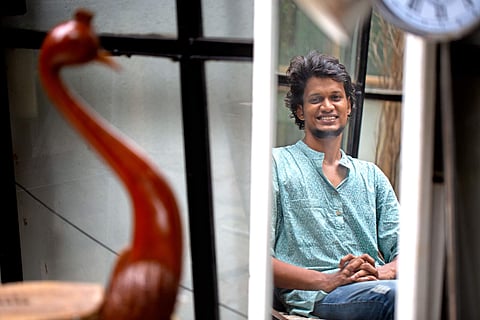

At the age of 17, Tharun Sekhar desired to get a lap steel guitar. Such was his desire that he traversed the length and breadth of his hometown Madurai in search of it. However, he couldn't track down the Hawaiian instrument anywhere. And that's when inspiration struck and he decided to make the lap steel guitar on his own. "The process was quite pleasurable and I decided to make more guitars and other stringed instruments," says Tharun. But it was only when he went to Auroville for his internship that he learned the technical aspect of instrument-making from a luthier named Erisa Neogy. "I discovered a passion for instrument-making and wanted to pursue it," adds Tharun.
Fuelled by his passion, Tharun began experimenting with his new hobby. He ended up making a banjo, cajon and several other guitars as well. But western instruments had little charm for the Architecture graduate. "Western instruments like the guitar has undergone several design changes over the decades. However, that is not the case with Indian classical instruments. This is why not many veer towards making Indian classical instruments when they begin. Even I wanted to make a guitar and not a veena. This is when I realised the need to reinvent and redesign some of our Indian classical musical instruments," recalls Tharun, who has been making instruments for the last six years.
Tharun didn't have to search long for inspiration or motivation to redesign these instruments. After seeing his work, a professor at Madurai's Thiagarajar College asked him to create the ancient Tamil musical instrument, the yazh. "A lot of research went into the process of making the yazh. No one has ever heard the instruments being played as it has completely gone out of use. You can find yazhs in museums but those aren't played. I looked through ancient Tamil texts to find out how to build the instrument properly. After much research, I came across a book called Yazh Nool, where the process was mentioned," says the 24-year-old, adding, "Several design changes were made — like using red cedar wood instead of the original type of wood mentioned. It sounded quite good due to the change in wood." Tharun made a Sengotti yazh, which means it has seven strings.
Speaking about what he wants to make in the future, Tharun says, "I want to experiment with different types of yazh. The one I made, was shaped like a swan. I want to make one that is shaped like a fish as well." He also wants to revive the old temple instrument panchamukha vadyam, which will be built with mud. "Before embarking on this ten-month-long yazh-making process, I decided to launch my venture called Uru with a bunch of my college mates. We work on multiple ventures, including graphic design, architecture, filmmaking and woodwork," signs off Tharun.
